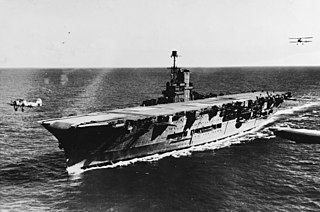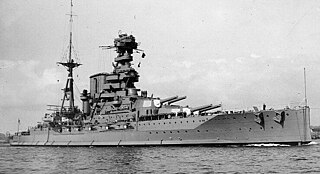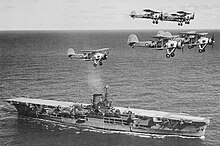
HMS Ark Royal was an aircraft carrier of the Royal Navy that was operated during the Second World War.

The Battle of Cape Matapan was a naval battle during the Second World War between the Allies, represented by the navies of the United Kingdom and Australia, and the Royal Italian navy, from 27 to 29 March 1941. Cape Matapan is on the south-western coast of the Peloponnesian Peninsula of Greece.
From 1939 to 1940, the French Third Republic was at war with Nazi Germany. In 1940, the German forces defeated the French in the Battle of France. The Germans occupied the north and west of French territory and a collaborationist régime under Philippe Pétain established itself in Vichy. General Charles de Gaulle established a government in exile in London and competed with Vichy France to position himself as the legitimate French government, for control of the French overseas empire and receiving help from French allies. He eventually managed to enlist the support of some French African colonies and later succeeded in bringing together the disparate maquis, colonial regiments, legionnaires, expatriate fighters, and Communist snipers under the Free French Forces in the Allied chain of command. In 1944, after the Allies had landed in Normandy and the southern front moved from North Africa across the Mediterranean into Italy and Provence, these forces routed the German Army, and Vichy officials fled into Germany.

Richelieu was a French fast battleship, the lead ship of the Richelieu class. Built as a response to the Italian Littorio class, Richelieu and its sister ship Jean Bart were based on their immediate predecessors of the Dunkerque class: they used the same unconventional arrangement that grouped their main battery forward in two quadruple gun turrets. They were scaled up to accommodate a much more powerful main battery of eight 380 mm (15 in) guns, with increased armor to protect them from guns of the same caliber.

HMS Resolution was one of five Revenge-class battleships built for the Royal Navy during the First World War. Completed in December 1916, Resolution saw no combat during the war as both the British and German fleets adopted a more cautious strategy after the Battle of Jutland in May owing to the increasing threat of naval mines and submarines.

HMS Barham was one of five Queen Elizabeth-class battleships built for the Royal Navy during the early 1910s. Completed in 1915, she was often used as a flagship and participated in the Battle of Jutland during the First World War as part of the Grand Fleet. For the rest of the war, except for the inconclusive action of 19 August 1916, her service generally consisted of routine patrols and training in the North Sea.

The attack on Mers-el-Kébir on 3 July 1940, during the Second World War, was a British naval attack on neutral French Navy ships at the naval base at Mers El Kébir, near Oran, on the coast of French Algeria. The attack was the main part of Operation Catapult, a British plan to neutralise or destroy neutral French ships to prevent them from falling into German hands after the Allied defeat in the Battle of France. The British bombardment of the base killed 1,297 French servicemen, sank a battleship and damaged five other ships, for a British loss of five aircraft shot down and two crewmen killed. The attack by air and sea was conducted by the Royal Navy, after France had signed armistices with Germany and Italy, coming into effect on 25 June.

Vittorio Veneto was the second member of the Littorio-class battleship that served in the Italian Regia Marina during World War II. The ship's keel was laid down in October 1934, launched in July 1937, and readied for service with the Italian fleet by August 1940. She was named after the Italian victory at Vittorio Veneto during World War I, and she had three sister ships: Littorio, Roma, and Impero, though only Littorio and Roma were completed during the war. She was armed with a main battery of nine 381-millimeter (15.0 in) guns in three triple turrets, and could steam at a speed of 30 knots.

The Battle of Madagascar was a Allied campaign to capture the Vichy French-controlled island Madagascar during World War II. The seizure of the island by the British was to deny Madagascar's ports to the Imperial Japanese Navy and to prevent the loss or impairment of the Allied shipping routes to India, Australia and Southeast Asia. It began with Operation Ironclad, the seizure of the port of Diego-Suarez near the northern tip of the island, on 5 May 1942.

In World War II, French West Africa was not a major scene of major fighting. Only one large-scale action took place there: the Battle of Dakar. The region remained under the control of Vichy France after the fall of France and until the Allied invasion of North Africa. French Gabon, the only colony of French Equatorial Africa not to join Free France after the armistice, fell to invading Free French Forces from the neighbouring colonies after the Battle of Gabon, further isolating West Africa.

The Battle of the Mediterranean was the name given to the naval campaign fought in the Mediterranean Sea during World War II, from 10 June 1940 to 2 May 1945.

Dunkerque was the lead ship of the Dunkerque class of battleships built for the French Navy in the 1930s. The class also included Strasbourg. The two ships were the first capital ships to be built by the French Navy after World War I; the planned Normandie and Lyon classes had been cancelled at the outbreak of war, and budgetary problems prevented the French from building new battleships in the decade after the war. Dunkerque was laid down in December 1932, was launched October 1935, and was completed in May 1937. She was armed with a main battery of eight 330mm/50 Modèle 1931 guns arranged in two quadruple gun turrets and had a top speed of 29.5 knots.

Although the history of the French Navy goes back to the Middle Ages, its history can be said to effectively begin with Richelieu under Louis XIII.

Strasbourg was the second and final member of the Dunkerque class of fast battleships built for the French Navy in the 1930s. She and her sister ship Dunkerque were designed to defeat the German Deutschland class of heavy cruisers that had been laid down beginning in the late 1920s, and as such were equipped with a battery of eight 330 mm (13 in) guns to counter the six 280 mm (11 in) guns of the Deutschlands. Strasbourg was laid down in November 1934, was launched in December 1936, and was commissioned in September 1938 as the international situation in Europe was steadily deteriorating due to Nazi Germany's increasingly aggressive behavior.

Le Fantasque was the lead ship of her class of six large destroyers built for the Marine Nationale during the 1930s. The ship entered service in 1935 and participated in the Second World War. When war was declared in September 1939, all of the Le Fantasques were assigned to the Force de Raid which was tasked to hunt down German commerce raiders and blockade runners. Le Fantasque and two of her sister ships were based in Dakar, French West Africa, to patrol the Central Atlantic for several months in late 1939. They returned to Metropolitan France before the end of the year and were transferred to French Algeria in late April 1940 in case Italy decided to enter the war. She screened French cruisers several times as they unsuccessfully hunted for Italian ships after Italy declared war in June.

Le Terrible was one of six Le Fantasque-class large destroyers built for the Marine Nationale during the 1930s. The ship entered service in 1936 and participated in the Second World War. When war was declared in September 1939, all of the Le Fantasques were assigned to the Force de Raid which was tasked to hunt down German commerce raiders and blockade runners. Le Terrible and two of her sister ships were based in Dakar, French West Africa, to patrol the Central Atlantic for several months in late 1939. They returned to Metropolitan France before the end of the year and were transferred to French Algeria in late April 1940 in case Italy decided to enter the war. She screened French cruisers once as they unsuccessfully hunted for Italian ships after Italy declared war in June.

The Free French Naval Forces were the naval arm of the Free French Forces during the Second World War. They were commanded by Admiral Émile Muselier.

HMS Fury was an F-class destroyer built for the Royal Navy in the 1930s. Although assigned to the Home Fleet upon completion, the ship was attached to the Mediterranean Fleet in 1935–36 during the Abyssinia Crisis. During the Spanish Civil War of 1936–1939, she spent time in Spanish waters, enforcing the arms blockade imposed by Britain and France on both sides of the conflict. The ship escorted the larger ships of the fleet during the early stages of World War II and played a minor role in the Norwegian Campaign of 1940. Fury was sent to Gibraltar in mid-1940 and formed part of Force H where she participated in the attack on Mers-el-Kébir and the Battle of Dakar. The ship escorted numerous convoys to Malta in 1940–41 and Arctic convoys during 1942.

Le Malin was one of six Le Fantasque-class large destroyers built for the Marine Nationale during the 1930s. The ship entered service in 1935 and participated in the Second World War. When war was declared in September 1939, all of the Le Fantasques were assigned to the Force de Raid, tasked with hunting down German commerce raiders and blockade runners. Le Malin and two of her sister ships were based in Dakar, French West Africa, to patrol the Central Atlantic for several months in late 1939. They returned to Metropolitan France before the end of the year and were transferred to French Algeria in late April 1940 in case Italy decided to enter the war. Le Malin played a minor role in the Norwegian Campaign in late April. After returning to the Mediterranean, she screened French cruisers several times as they unsuccessfully hunted for Italian ships after Italy declared war in June.

L'Audacieux was one of six Le Fantasque-class large destroyers built for the Marine Nationale during the 1930s. The ship entered service in 1935 and participated in the Second World War. When war was declared in September 1939, all of the Le Fantasques were assigned to the Force de Raid, tasked to hunt down German commerce raiders and blockade runners. L'Audacieux and two of her sister ships were based in Dakar, French West Africa, to patrol the Central Atlantic for several months in late 1939. They returned to Metropolitan France before the end of the year and were transferred to French Algeria in late April 1940 in case Italy decided to enter the war. She screened French cruisers several times as they unsuccessfully hunted for Italian ships after Italy declared war in June.






















